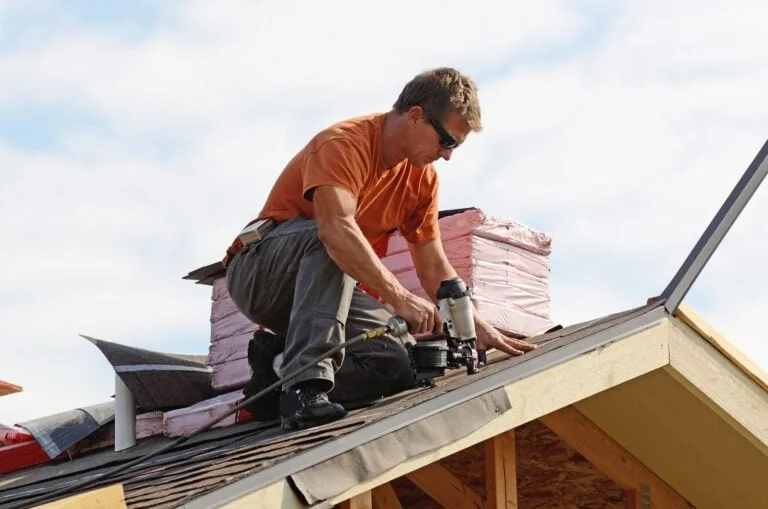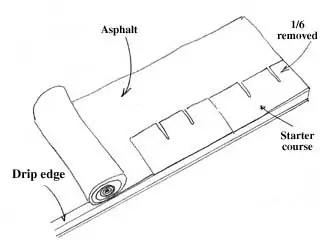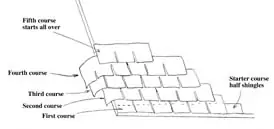If you own a home long enough, sooner or later you will have to consider reroofing. If you suspect problems, make a thorough inspection of your roof. Asphalt or composition shingles will usually last from 20 to 40 years, depending on local climate, the quality of the shingles, quality of installation and with regular maintenance. If your roof is over 20 years old, it should be inspected yearly. Overall age is a good indicator of whether or not reroofing is needed. Several signs can also indicate deterioration and forthcoming problems. Incidentally, when purchasing a home, a roof inspection is one of the most important things you can do.
Inspection The first sign of deterioration is obvious — a leak. If you find one leak, or even two, in a specific location sometimes you can patch the roof or re-gutter to prevent ice dams to solve the problem. Leaks, indicated by water stains in the house, wet areas under the roof deck or in the attic spaces, are a sign of serious roof problems, and you1ll probably have to reroof.
If you find excessive amounts of the tiny protective mineral granules, which normally cover the shingles, in gutters or beneath the downspouts, this normally indicates excessive weathering. Also, black spots in the roof indicate loss of the granules.
As shingles age, they tend to curl up and crack, especially on the Southern and Western exposures where they get the most ultraviolet rays. This causes the shingles to lose their water resistance and creates openings where water can leak through.
Another important sign is missing shingles. If only one or two shingles are missing, you can often simply repair or replace. Numerous missing shingles, however, means you1ll probably have to reroof. And, of course, after a major wind or hail storm you will probably have to consider reroofing.
Walking on a roof can be dangerous, even when doing the roof inspection. Take extra care. If possible, make the inspection from the ground, using binoculars to examine the shingles and their surfaces.
Removing Old Shingles The next step is to determine if you will be able to re-cover existing shingles, placing a new roof over the old shingles, or if the old shingles will have to be removed. The latter is called a “tear-off” job by professionals. In many instances, new asphalt shingles may be applied over old asphalt shingles, roll roofing and wood shingles. New shingles cannot be applied over slate or wood shake shingles.
The decking should also be solid enough to provide good anchorage for the roofing nails. The nails must completely penetrate 5/8-inch sheathing and go at least 3/4-inch into solid decking. In some cases, the old decking may be strips with openings between and should be replaced. If the existing deck is in good shape, the old shingles are not excessively warped or curled and there aren1t too many layers of existing shingles, you can usually leave the old shingles in place. Local building codes may also restrict the number of layers that can be applied before it is mandatory to tear off the old shingles. You should also consider whether the decking is strong enough to hold the new shingles and the weight of the workers. In most instances it is best that roofing layers be limited to two; in other words, you can usually reroof once before tearing off.
Do-It-Yourself or Pro The next step is to determine if you can do the job yourself. Reroofing is hard work, and it can be extremely hazardous, especially reshingling a multiple story house and/or a house with steep roof pitches. The latter requires special scaffolding that you will need to rent or purchase. If you1re not afraid of heights, or hard work, the techniques needed for reroofing are not especially difficult. And, you can save approximately 50 percent of the cost of reroofing by doing the job yourself.
Tools For steep pitches you1ll need scaffolding, ladder hooks or jacks and ropes. You should also have tarps to cover the roof in case of inclement weather. Then watch the weather. In addition to a means of nailing down the shingles, you’ll need a good utility knife, a heavy sheath, straight edge and chalk line. Always cut from the back side of the shingle as this doesn1t dull the blade as does cutting through the granules on the front. A flat shovel, pry bar and claw hammer are needed for tear-off jobs.
Shingles can be applied with roofing nails and a hammer. A pancake type air compressor and a coil roofing nailer makes the job easier and quicker, even for a first timer. These tools can often be rented along with the other specialty tools required, but you should figure in this cost when determining whether you want to do the job yourself or contract it. Don’t forget to add in the cost of hauling off and dumping the old shingles for tear-off jobs.
Selecting Shingles Composition asphalt shingles are used on the majority of houses in the United States. Compared to other products, they are the most practical and are priced reasonably. For the most part, they can be expected to last between 20 and 40 years. This article relates primarily to reroofing with asphalt shingles. Several considerations should be made when reroofing, and the first is color. Shingles are available in a wide array of colors. It1s a good idea for the shingles to match or harmonize with the exterior color of the home. Darker colors are more popular in colder climates, while lighter colors are more popular in warm sunny climates. In both instances these colors can result in energy savings. Light colors tend to make a small house look larger, dark colors can make a large house look smaller. It’s also a good idea to keep a general color scheme that matches your neighborhood.
According to the Asphalt Roofing Manufacturers Association (ARMA), the typical roof shingle has undergone some dramatic advances in recent years. A wide variety of shingles can be found with a variety of colors, styles, sizes and incorporating unique performance and architectural features. For instance, the demand for fire-resistant shingles has grown dramatically in recent years, especially in the brush fire-prone areas of the West and Southwest. In high-wind and hurricane areas, special wind-resistant shingles can provide additional protection for a home’s roof, and by extension, its contents. Impact resistant shingles may be considered in areas where hail damage is a concern. In the warm, humid areas of the United States, algae-resistant shingles can help homeowners protect their roofs against shingle discoloration.
Three-tab shingles are the most common and most economical. The waterline created in their installation can, however, eventually become eroded. One of the more popular shingle styles these days is the laminated shingle, which is manufactured with one or more layers of tabs or laminated cutouts to create additional thickness to the shingle or a solid surface. With their shadowing effects, laminated shingles give a visual depth and a custom look to a roof. Because there is no waterline, as on three-tab shingles, the laminated shingles also tend to last longer. Local building codes may specify the rating of the shingles that can be used in your area.
Except for mansard roofs, most composition shingles are held in place with four fasteners.
Estimating
Shingles are estimated in squares. One square of roofing shingles covers 100-square feet of roof. Shingles come in packages to make up one square. The number of packages needed for a square depends on the type of shingle and the number of shingles in the package. Shingles are also measured by their weight, with the heavier and more durable shingles, weighing 235 pounds, common for most roofing applications. This means a square of shingles weighs 235 pounds. When ordering shingles, simply measure the square footage of the entire roof and divide by 100 to determine the number of squares needed. Add about 5 to 10 percent for starter courses, ridge caps and waste.
Tear-Off The old shingles are first removed with a wide, flat shovel, using a claw hammer and pry bar to loosen stubborn nails. Use the pry bar to loosen and remove the flashing around the soil stacks and vents. Tear-off creates a large amount of debris. As you go, continue to sweep the debris off. Loose debris causes a hazard, especially on a steep roof. You should also have some method of collecting the debris and preventing it from damaging shrubs or flowers planted near the house. And, when you finish the tear-off, you must have some place to dispose of the debris, and there will be a lot of it.
Once the old shingles and asphalt paper covering the deck have been removed, carefully inspect the decking for rotting or holes and replace any defective decking. Small holes can be patched over with pieces of flashing. Make sure all nails have been removed from the decking.
For roofs with a pitch of 4-inches or better, a layer of No. 15 asphalt-saturated felt should be applied. Begin at the bottom edge of the roof, and overlap each course 2-inches over the lower layer. Roofing felt has lines printed on it to help lay straight courses. The felt should be lapped 6-inches from both sides of hips and ridges. Nail the felt every 2-inches along the outside edges. New drip edge should be applied on all edges.
Shingling Basics Before you start the job, thoroughly inspect and repair or replace any rotting wooden trim, soffit and guttering. Don’t reroof, especially with a tear-off, unless there is no forecast of rain within the next 72 hours. If the shingles are to be applied over existing shingles make sure you nail down any loose shingles or replace those that are missing to create a smooth surface. Drive down all loose or protruding nails. Nail down the pieces of split or curled shingles. Replace all worn edging or drip cap with new. Again, before beginning the reroofing sweep all debris from the surface.
At this point the tactics are the same, regardless of whether applying over decking or existing shingles. Most shingle bundles or packages come with specific instructions for application.
If at all possible have the roofing dealer place the shingle bundles on the roof so you don’t have to carry all the shingles up a ladder. This is not only dangerous, but extremely hard work. Most roofing dealers will place the shingles on the roof at no extra cost.
A starter course of shingles is first installed along the bottom edge of the roof. This is done by first cutting the tabs off shingles, and applying the course upside down or with the uncut edge on the bottom roof edge and just flush with the edge of the drip cap or metal strip. Some installers use a full width shingle for the starter course. Before beginning, cut 3-inches off the side of the first shingle. This prevents the cutouts in the next course of shingles from matching those of the starter course.
Regardless of whether on bare decking or old shingles, the fist step is to lay a starter course. This may consist of half shingles or whole shingles with the tabs laid up. If on bare decking, asphalt roll roofing must first be applied. New drip edge is always installed all around the decking.
Begin the first course with a full shingle. If applying over existing shingles, the top edge of the shingle should line up with the butt edge of the old shingle in the course above. If needed, trim the shingle to fit. This is called “butt-and-run” and can only be done if the existing shingle runs are straight. If the existing shingle runs are not straight, you will have to first snap a straight line.
Fasten the shingles in place on the nailing indicators. On three-tab shingles, remove half a tab, or one-sixth of the shingle from the outside edge of another shingle and fasten it above the first course to create the second course. Then cut a full tab from a shingle and lay it to begin the third course. The fourth course begins with a tab and a half off. The fifth course is a full shingle, in the same manner as the first course. Then repeat the pattern going up the rake. It’s best to work upward in a triangular fashion moving up and across at the same time rather than laying one single course, then another single course, then another the entire length of the roof. This method means you don1t have to move around as much, and creates less noticeable difference if there is some package color differences in the shingles. Professional roofers don’t cut the beginning shingles, they simply let the shingles overhang the edge, then cut away when they finish the edge.
Another shingling pattern may also be used. It’s more work at first, but creates a fast method once started. In this case each course is cut in increasing sixths to create the four courses.
Installation of laminated shingles is different. Because there basically is no tab to locate cuts, most professionals install them with a 7- to 8-inch gauge.
Because there are no tabs to gauge the cuts, laminated shingles are cut and laid on a 7- to 8-inch gauge. Shown is a typical example, but because the design of the laminate can be different, it’s important to follow the gauge specified by the manufacturer.
Make sure you align each shingle carefully, following manufacturers exposure specifications. In most instances this means the butt edge of the tabs align with the top of the cutouts in the course below. Fasten with four nails per shingle, making sure the nails are driven straight and not angled where they can cut into the shingle.
It’s also best to begin the shingling job at the rake that is the most visible, and work toward the rake that is less visible.
Remove the old ridge cap before you bring the courses up to the ridge. You can purchase special ridge cap shingles or simply cut three-tab shingles in thirds. Laminate shingles require special ridge cap shingles. Begin by bending a cap piece over the ridge and along the centerline of the shingle. If the weather is cold then take the pieces inside to warm them. Fasten in place with a nail on each side 5 1/2 inches from the exposed end, and 1 inch up from the shingle edge. The next shingle should overlap to create a 5-inch exposure. Lay the laps away from the prevailing wind direction.
Valleys may be flashed and the shingles cut in a straight line along the valley edge, or the valleys may be laced. Although lacing is a bit more complicated, it provides a tighter, more sturdy and less leak-prone roof. Lacing is the most common these days and is the most popular with the experts. To lace a valley the shingles are interlaced as the course goes up the valley, creating a solid, shingled surface.
Most valleys are laced these days, interlacing the shingles. The outer layer is then cut on a sraight line through the centerline of the valley.
And remember: Don’t attempt to shingle in extremely cold or extremely hot weather. In cold weather the shingles can break, and in hot weather you can mark and scar shingles with your feet.
Editor’s note: For more information, check out the ARMA web site at www.asphaltroofing.org.












